Dexterous and fresh, the fourth installment of Photo Cairo describes itself as an “International Visual Arts Festival in Downtown Cairo,” and features exhibitions, screenings, presentations, residencies, a workshop and a temporary publishing house. Organized by Contemporary Image Collective (CIC)1 and curated by Aleya Hamza and Edit Molnar, Photo Cairo4: The Long Shortcut is a comprehensive yet concise presentation of lens-based practices that aims to explore the “dynamics between informal and official modes of operation that continue to shape the social reality in this region and beyond.”2 The exhibition showcases international artists, with a strong presence of Egypt and other Arab nations. Between its venues and events, pathways open into the city, inviting the visitor to engage with tentacles and slivers of Cairo’s unfathomable historical depth and experiential breadth.
While deeply connected to the city, Photo Cairo4 balances local specificity and globalized contemporary art discourse, prompting the visitor to search for the best means to think about contemporary art within a global context. Perhaps their supposed accessibility (in making and in viewing) earn still and moving images their dominance in the global art circuit, recalling the purportedly universal aims of formalism, an artistic concentration that in earlier eras was thought to function as common language. However, if we understand the position of photography, and subsequently video, as signifying a return to Modernist universalism, we remain within the disciplinary parameters of Western art history, and may only arrive at a partial perspective on how the international art world is developing today.
Here, art historian George Baker’s call to map the transformation of photography and to account for the medium’s “expanded fields” of practice becomes pivotal. utilizing discipline-based parameters, Baker works to ground photography’s malleable existence and predict its possible developments, specifically in its relationship to the moving image.3 I find Baker’s conception of mapping useful in thinking not only of lens-based images but also as a bridge to thinking about the “expanded expansion” of the larger art world. For a variety of reasons, in Egypt, as in many of the countries contributing to the global conversation of art today, some of the foremost art practitioners have not been trained within official art programs. Consequently, canonical perspectives of art history, especially Western art history, are not the main context of their interventions.4 Instead, we see within their practice a host of different intellectual and social concerns. Correspondingly, many of the works in Photo Cairo4 serve to analyze and demonstrate these histories and conditions to their viewers, or slyly reclaim photography to critique its cooption within an ideological frame.
In “Photography’s Expanded Field,” George Baker revisits Rosalind Krauss’s groundbreaking 1978 analysis of sculpture’s expansion from its Modernist form into a Postmodern semiotic “field.”5 Baker does so in order to explore photography’s resilience and expansion into a cultural arena that includes the film still, the directorial mode, and the advertisement (exemplified, among others, by Cindy Sherman, James Coleman, and Jeff Wall). Taking into consideration that photography’s condition as a fine art is different than that of sculpture, the “mapping” of the field’s expansion can follow Krauss’ logic, but must then also take into account the fact that the context of art-making and its circulation in the last twenty to thirty years has dramatically changed. I agree with Baker’s premise, to which I kept returning as an anchor while viewing the show. However, it becomes evident through Photo Cairo4‘s thesis that this expansion will also have to extend beyond the disciplinary parameters of art history and criticism in order to understand the place of the photographic in a globalized artworld. Photo Cairo4 speculates what tools are needed to look at art generated in an international context, and begins to chart how we can map the intervention of art within photography’s overwhelming intensification. As such, instead of expanding from within photography’s history as a fine art outwards, the work in the exhibition intervenes into the field of fine art from without, by questioning photography’s relation to cinema, news media, popular culture, personal archives and systems of knowledge.
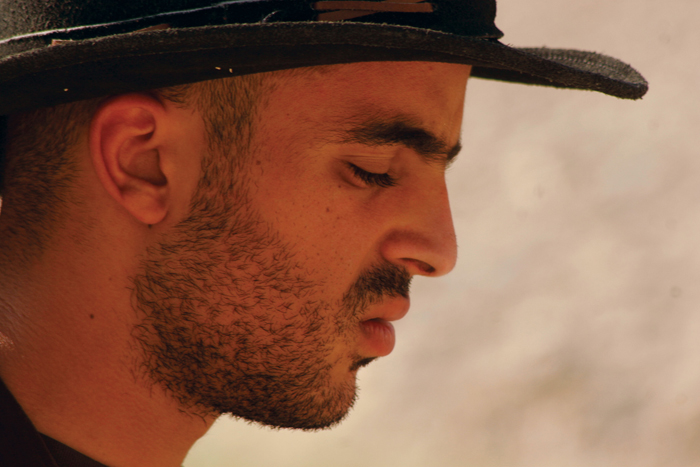
Ihab Jadallah, The Shooter (El Takheekh), 2008. Video still, single-channel video, 8 min. Image courtesy of Contemporary Image Collective.
The ideological dimension of the captured image in mainstream media and cinema is a major preoccupation of Photo Cairo4. In Ihab Jadallah’s The Shooter (El Takheekh) (2008), the artist triangulates a political reality with the influences of Hollywood and broadcast-media, underscoring our inability to distinguish cause from effect. In this short video, the character of an iconic American cowboy turns into a Palestinian freedom fighter, and then is subsequently revealed to be an actor in a drama staged by international media. Jadallah (a Palestinian residing in Spain) indicts not only the vampiric ways in which news services and corporations exploit the ongoing crisis in Palestine, but also turns his analysis on how the media not only sustains mythologies of heroism, but also produces new ones in its own image.
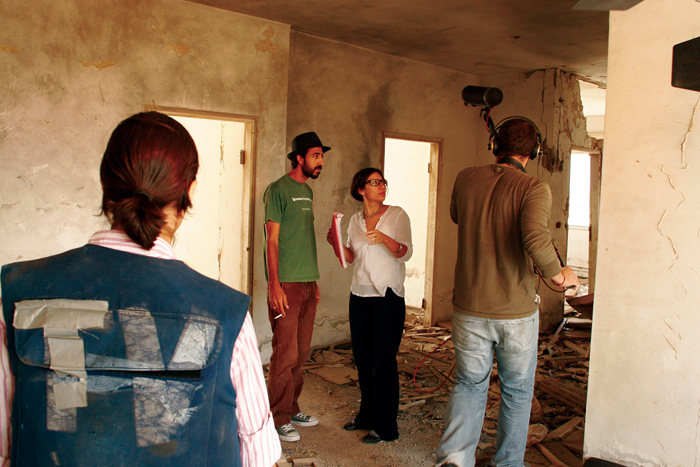
Ihab Jadallah, The Shooter (El Takheekh), 2008. Video still, single-channel video, 8 min. Image courtesy of Contemporary Image Collective.
Photo Cairo4 puts into orbit a broad range of concerns, where photography’s role is not inscribed only through its fine art status, but where its multiple functions in our lives influence its uses and meaning in art. In On red nails, palm trees and other icons (2007-2008), Egyptian born Hala Elkoussy hangs salon-style a collection of over 300 found images that relate to the history of Cairo since its renewal under a Western model in the late 1800s. Complete with a desk and a rug, this atmospheric library of pictures is created to “reflect shifting value systems,” referencing the city’s constant rapid transformation and the failed promises of modernity.6 By weaving nostalgia into the faux-museological taxonomy, Elkoussy introduces an idiosyncratic system of classification that compels the viewer to read the historical materials against their grain.
Agency’s Specimens (1992-ongoing) at the CIC Gallery also employs conventions of display in order to disrupt the authoritative status of institutional presentation.7 Specimens is a project that consists of amassing a collection of items that fall into the interstices of binary definitions. The items on display all relate to copyright disputes that revolve around the distinction of creativity from fact. The contested objects thus reflect one of photography’s historical dilemmas–its existence as both document and art form. The slippage introduced by the objects and their display declassifies the artwork’s own logic; the exhibited objects fall between the definition of a work of art and a mere artifact or document to be presented as evidence for the argument presented.
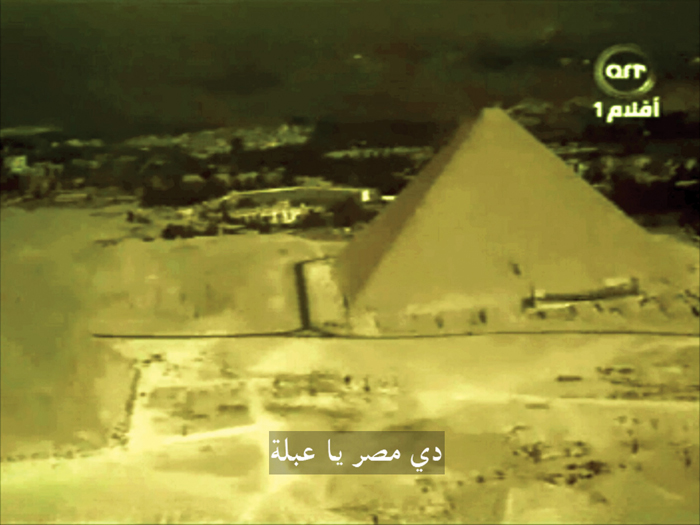
Maha Maamoun, Domestic Tourism II – The Film, 2008. Single-channel video. Image courtesy of Contemporary Image Collective.
The impulse to rethink existing images persists in Maha Maamoun’s video Domestic Tourism II–The Film (2008). With spliced footage from a rich inventory of Egyptian Cinema, Maamoun assembles a provisional narrative in which each clip features the iconic Giza Pyramids. The clips advance chronologically to a peak, and then proceed in reverse chronology; the structure of the video mimes the outline of a pyramid. The work critiques the ways in which reality is recast as representation to perpetuate mythologies, yet sustains a sense of ambivalence, as the rich vocabulary of innuendo inherent to these films is made visible, even beyond cultural difference, through the shared codes of cinema.
In Hassan Khan’s video installation The Hidden Location (2004), a sequence of seemingly unconnected vignettes are projected onto four screens surrounding the viewer. Each episode–some in Arabic, some in English–is fragmented onto the four screens. Sharing content, but differing in terms of camera-work, editing, and sound, each section causes the viewer to spin around in an attempt to “complete the picture,” which takes place simultaneously in the front, back and on the sides. The variations between sequences and their internal logics are so great that it seems like the artist is trying to make an inventory of the entire vocabulary of cinema and video usage. A few examples give a sense of this diversity. A close-up of a woman driven to hysteria by her attraction to a destructive lover is juxtaposed with her dramatically tall figure pacing through the city at night, and her dialogue with a friend in a public restroom. In another episode, the choreography of corporate life is projected on three screens, where actors exaggerate roles and activities inside a bright yellow prop, while on the fourth screen a consultant in a luxurious office explains her strategies of fine-tuning corporate puppets. In another part, a detached door, a bed and a kitschy salon ensemble are signifiers employed by an interlocutor, played by the artist himself, to help Mo, a character donning a blue-collar uniform, understand himself, and the reasons of a failed love-match. The protagonists split hairs in a comic attempt to deduce the narrowest parameters of cultural specificity along the lines of taste, working to refine typologies within the category “Hameda,” which, as Mo explains, is a “a member of the Egyptian bourgeoisie.” The bold artificiality of the digital collage (used only in this vignette), where the figures float around a flat background with a yellow halo around their silhouettes, isolates the figures from their “reality,” thus underscoring the absurdity of the characters’ (and by extension humanity’s) quest for understanding phenomenon through categorization and definition.
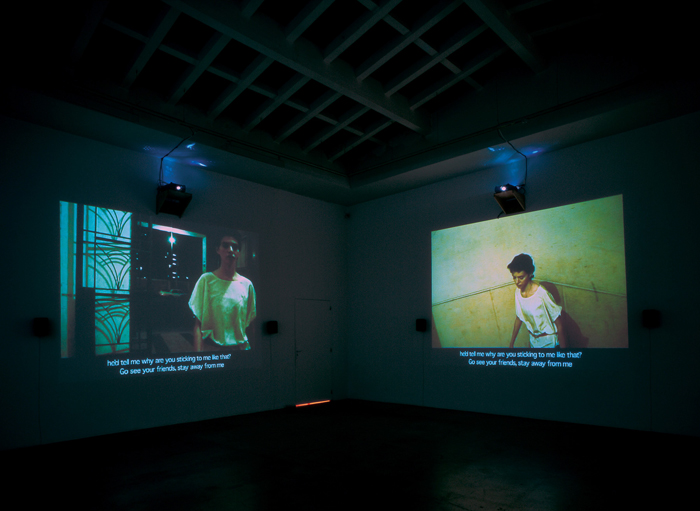
Hassan Khan, The Hidden Location, 2004. Video still from four-channel video installation. Duration: 52 min. Exhibition view, Galerie Chantal Crousel, 2004. Courtesy of the artist and Galerie Chantal Crousel. Photo by Hassan Khan.
The video camera in its informality and relationship to public media is central to the project, Khan explains, as is the relationship between cinema and video, as he emphasizes: “a shared meta-history of the image itself exists.” More specifically, he continues: “The Hidden Location also functions in some sort of way as a practice of an ‘expanded’ form of cinema.”8 This expanded form draws from multiple techniques used in cinema into other domains of the captured image such as television, closed-circuit surveillance, hand-held cameras and home-video aesthetics, while also pulling from art, theater and performance.
An assortment of styles, genres, techniques and tropes, The Hidden Location is an anthology of subtleties, cultural (or shared), idiosyncratic (or personal), not meant to be decoded for specific meaning, but to function more as a lexicon of varying approaches, styles and uses of the moving image. The desire for closure is persistently frustrated by the structure of the projection and its truncated accounts, offering instead partiality, relativity and the impossibility of objectivity. This is underscored by the ways the installation induces a split between our physical reaction and our natural drive to comprehend a narrative. Prompted by a sound or a voice, the shifting frames cause the viewer to constantly turn, instinctively chasing the story. The multiple possibilities of meaning within each fragmented story consistently place and displace the viewer’s relationship to the material, foregrounding the syntax that creates unity in a cinematic sequence.
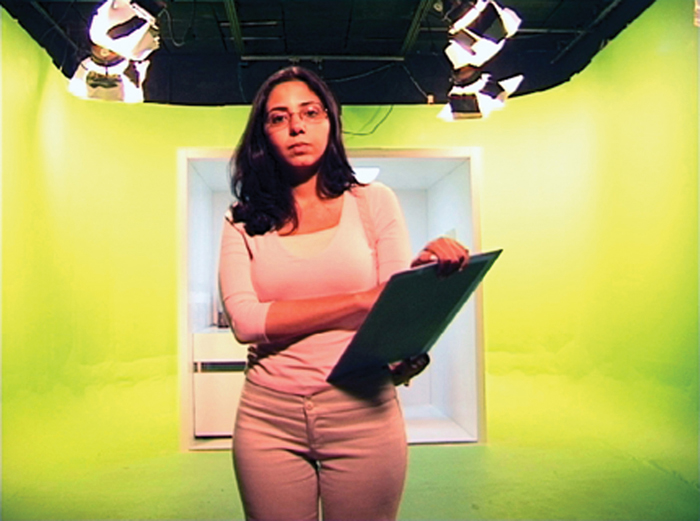
Hassan Khan, The Hidden Location, 2004. Video still from four-channel video installation. Duration: 52 min. Exhibition view, Galerie Chantal Crousel, 2004. Courtesy of the artist and Galerie Chantal Crousel. Photo by Hassan Khan.
What unifies the work in Photo Cairo4 is the relentless questioning of the ubiquity of the captured image in and around contemporary life. Thus the term “photo,” central to understanding these contemporary practices, does not mark a unification around a medium or its expansion, but rather the conversion of multiple cultural and social practices towards fine arts as a laboratory for understanding meaning, not only through its internal structure, but as affected by ideology.
Photo Cairo4 brings a diverse set of concerns to bear on the question of the visual image today: its origins in photography, its past and present work as a taxonomic tool, its role in inscribing histories of cultures and subjects, its place as personal document, and its exponential expansion through the media into massive circulation, as rapid technological advancements such as cellphone photography and online distribution make it omnipresent. Foregrounded in Cairo is a concern with an analysis of representation and the power of the image, as well as a structural analysis of categories and systems of classification.
A city observed for centuries, Cairo is now providing lenses and compasses to help visitors relearn how to see and interpret. Photo Cairo4 disallows overview, completeness, conclusion, or any possibility of masterful knowledge reflecting the conditions that characterize our connected, yet diffused, international present. Instead, the artworks on view lower ladders and carve pathways for the viewer to navigate specific moments within the megalopolis, granting not a picture of the city, but a clue to its operations, mechanisms, and ideologies to use as a map.
Dr. Nizan Shaked is an Assistant Professor of Contemporary Art History, Museum and Curatorial Studies at California State University Long Beach. In 2008, Shaked (along with three others) received an Emily Hall Tremaine Exhibition Award for How Many Billboards on the Boulevard?, a large outdoor exhibition of commissioned billboards slated to launch in 2010.
